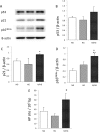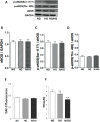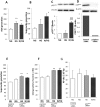Intermittent high glucose implements stress-induced senescence in human vascular endothelial cells: role of superoxide production by NADPH oxidase
- PMID: 25879533
- PMCID: PMC4400006
- DOI: 10.1371/journal.pone.0123169
Intermittent high glucose implements stress-induced senescence in human vascular endothelial cells: role of superoxide production by NADPH oxidase
Abstract
Impaired glucose tolerance characterized by postprandial hyperglycemia, which occurs frequently in elderly persons and represents an important preliminary step in diabetes mellitus, poses an independent risk factor for the development of atherosclerosis. Endothelial cellular senescence is reported to precede atherosclerosis. We reported that continuous high glucose stimulus causes endothelial senescence more markedly than hypertension or dyslipidemia stimulus. In the present study, we evaluated the effect of fluctuating glucose levels on human endothelial senescence. Constant high glucose increased senescence-associated-β-galactosidase (SA-β-gal) activity, a widely used marker for cellular senescence. Interestingly, in intermittent high glucose, this effect was more pronounced as well as increase of p21 and p16INK4a , senescence related proteins with DNA damage. However, telomerase was not activated and telomere length was not shortened, thus stress-induced senescence was shown. However, constant high glucose activated telomerase and shortened telomere length, which suggested replicative senescence. Intermittent but not constant high glucose strikingly up-regulated the expression of p22phox, an NADPH oxidase component, increasing superoxide. The small interfering RNA of p22phox undermined the increase in SA-β-gal activity induced by intermittent high glucose. Conclusively, intermittent high glucose can promote vascular endothelial senescence more than constant high glucose, which is in partially dependent on superoxide overproduction.
Conflict of interest statement
Figures






References
-
- Minamino T, Komuro I. Vascular cell senescence: contribution to atherosclerosis, Circ Res. 2007;100: 15–26. - PubMed
-
- Yokoi T, Fukuo K, Yasuda O, Hotta M, Miyazaki J, Takemura Y, et al. Apoptosis signal-regulating kinase 1 mediates cellular senescence induced by high glucose in endothelial cells. Diabetes 2006;55:1660–1665. - PubMed
Publication types
MeSH terms
Substances
LinkOut - more resources
Full Text Sources
Other Literature Sources

